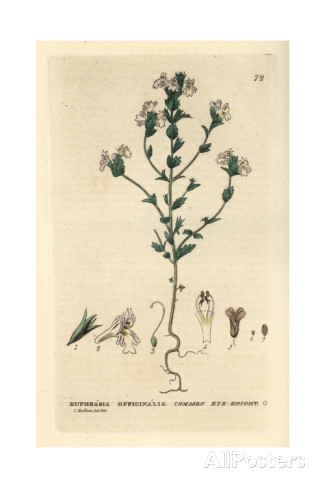Dr Clare Materia Medica
Introduction to the Dispensing of Dr Clare’s Blended Herbs
Special | A | B | C | D | E | F | G | H | I | J | K | L | M | N | O | P | Q | R | S | T | U | V | W | X | Y | Z | ALL
E |
|---|
Eyebright
Augentrostkraut, Eufrasia, Euphrasia, Euphraisia Eye Bright, Euphrasiae herba, Eye Bright, Herbe d'Euphraise. Scientific Name: Euphrasia rostkoviana; Euphrasia officinalis; Euphrasia stricta. People Use This For: Orally, eyebright is used to treat nasal mucous membrane inflammation, allergies, allergic rhinitis, common cold, bronchial conditions, and sinusitis. It is also used orally for cancers, coughs, conjunctivitis, earaches, epilepsy, headaches, hoarseness, inflammation, jaundice, ophthalmia, rhinitis, skin ailments, and sore throat. Safety: POSSIBLY SAFE...when used orally and appropriately (5). ...when used orally in amounts commonly found in foods. Eyebright is listed by the Council of Europe as a natural source of food flavoring (1). Effectiveness: There is insufficient reliable information available about the effectiveness of eyebright. Mechanism of Action: Tannin constituents may be responsible for astringent properties (1). The constituent caffeic acid has bacteriostatic activity (1). Constituents, aucubin and iridoid glycosides, have purgative activity (1). Adverse Reactions: Orally or topically, 10-60 drops eyebright tincture may induce mental confusion, headache, increased eye pressure with lacrimation, itching, redness, swelling of eyelid margins, dim vision, photophobia, weakness, sneezing, nausea, toothache, constipation, cough, dyspnea, insomnia, polyuria, and sweating (1). Interactions with Herbs & Supplements: None known. Interactions with Drugs: None known. Interactions with Foods: None known. Interactions with Lab Tests: None known. Interactions with Diseases or Conditions: None known. Dosage/Administration: ORAL: 2-4 grams dried above ground parts three times daily (1), or one cup tea (steep 2-4 grams dried above ground parts in 150 mL boiling water 5-10 minutes, strain) three times daily (1). Liquid extract (1:1 in 25% alcohol), 2-4 mL three times daily (1). Tincture (1:5 in 45% alcohol), 2-6 mL three times daily (1). Editor's Comments: Avoid use of nonsterile solutions (including homemade products) in the eye(s), due to high risk of infection. Ophthalmic application of eyebright is not recommended. Historically, eyebright has been used in British Herbal Tobacco, which was smoked for chronic bronchial conditions and colds (2). Specific References: Eyebright
| |

 Also Known As:
Also Known As: